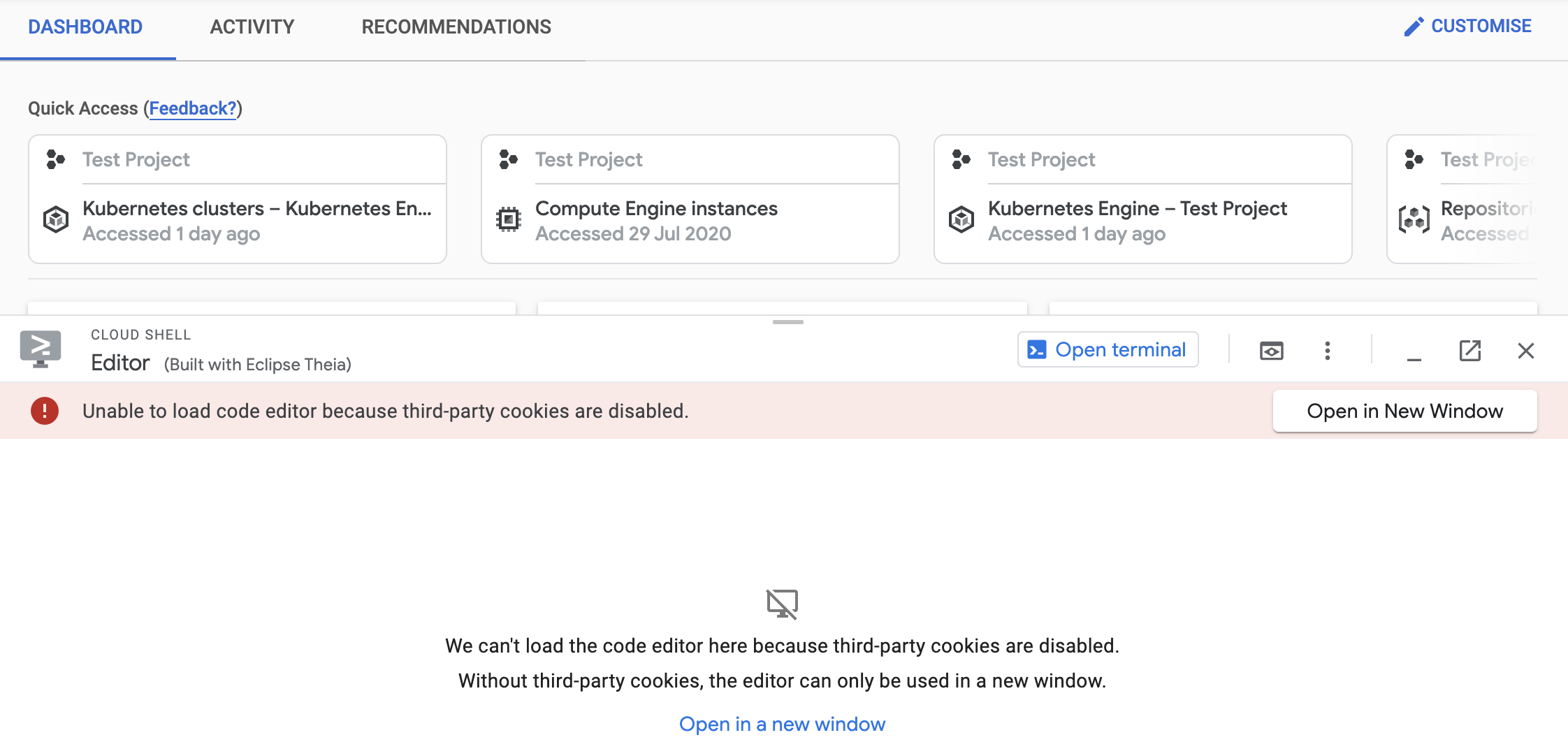Cloud Shell with Cloud Code integrated, as of the latest release, has the following known limitations and restrictions.
Usage quotas
The default weekly Cloud Code quota is 50 hours.
Viewing your weekly Cloud Code quota
If you reach your quota, you'll need to wait until the date and time specified before you can use Cloud Code again or check with your Cloud Code administrator to increase your quota.
To view your weekly quota:
- Click
 Session information and then click Usage quota.
A dialog appears and displays the hours remaining in your quota, the total
number of hours in your quota, and the date and time that the quota resets.
Session information and then click Usage quota.
A dialog appears and displays the hours remaining in your quota, the total
number of hours in your quota, and the date and time that the quota resets.
If you need more quota, we strongly recommend upgrading to Cloud Workstations, which does not have weekly usage limitations. Cloud Workstations lets you customize, rightsize and secure your development environment. Upgrade to Cloud Workstations for managed secure development environments provisioned in your VPC without usage limits.
Cloud Code inactivity
To prevent your $HOME directory from being deleted due to inactivity for 120
days, start a session. For sensitive data you want to store long term, consider
a different solution on Cloud Storage.
Non-interactive usage
Cloud Code is intended for interactive use only. Non-interactive sessions are ended automatically after 40 minutes. Cloud Code sessions are capped at 12 hours, after which sessions automatically terminate. You can start a new session immediately after.
Restoring a session after a service limit violation
If your session is terminated or can't be established because you exceeded a service limit, Cloud Code displays an error with a link to a form that allows you to appeal the limit violation. Click the feedback link and submit the form with more information about the tasks you were performing before your session was terminated.
Limitations and restrictions
Custom installed software packages and persistence
The virtual machine instance that backs your Cloud Code for Cloud Shell session
isn't permanently allocated to your Cloud Code session and terminates
if your session is inactive for 40 minutes. After the instance is terminated, any
modifications that you made outside your $HOME directory are lost.
To have your configurations persist across sessions, consider customizing your environment.
Users younger than 18 or whose age is unknown
Cloud Code isn't available to users younger than 18 or whose age is unknown. By default, Google Workspace for Education blocks access to Cloud Code for all users. If your institution has students older than 18 who you want to have access to age-restricted services including Cloud Code, see Control access to Google services by age for steps to identify users who are 18 years or older.
Cloud Shell Editor extensions
Cloud Shell Editor does not support the installation of custom editor extensions. However, the Cloud Shell Editor comes with a set of essential extensions already installed and kept up-to-date.
.bashrc content
Cloud Code can produce errors if the .bashrc file is modified or
deleted. The .bashrc file must contain the following lines:
if [ -f "/google/devshell/bashrc.google" ]; then
source "/google/devshell/bashrc.google"
fi
gcloud output formatting
By default, Cloud Code enables
gcloud accessibility features.
With accessibility features enabled, gcloud table output
is rendered as a flattened list of items.
To restore the default behavior of boxed tables for many commands, append
the following command to the end of your $HOME/.bashrc file:
gcloud config set accessibility/screen_reader false
Slow connection performance
Connecting to a Cloud Code for the first time involves creating your home disk and can currently take up to 25 seconds. Subsequent connections to existing virtual machine instances take about five seconds. However, if you haven't used Cloud Code for a week, connection performance will be slower since the home directory is restored from an archive.
Cloud Code also offers Ephemeral mode which is the Cloud Code experience without persistent disk storage. Ephemeral mode offers faster connection performance but all the files you create in your session are lost on session end.
Browser support
Cloud Code supports the latest versions of Google Chrome, Mozilla Firefox, Microsoft Edge, Microsoft Internet Explorer 11+, and Apple Safari 8+. Safari in private browser mode is not supported.
Private browsing and disabled third-party cookies
The Cloud Shell Editor can't load in Cloud Code if third-party cookies are disabled. Some browsers have third-party cookies disabled by default and most browsers' Incognito or Private Browser modes block these cookies as well.
With third-party cookies disabled, you can still use the
Cloud Shell Editor in its own window by
clicking the Open in New Window button accessible when you open an
editor session  .
.
Alternatively, you can navigate to port 970 using the Web Preview
 .
.

Tip: If you're using Google Chrome, you can enable third-party cookies
by clicking the Third-party cookie blocking icon in your address bar
 ,
selecting Site not working?, clicking Allow cookies, and reloading your
page.
,
selecting Site not working?, clicking Allow cookies, and reloading your
page.
Disk storage
Cloud Code provisions 5 GB of free
persistent disk storage mounted as
your $HOME directory on the virtual machine instance. This storage is on
a per-user basis and is available across projects. All files you store in your
home directory, including installed software, scripts, and user configuration
files like .bashrc and .vimrc, persist between sessions and count towards
the 5 GB limit.
Clearing disk space
If you encounter a no space left on device error, free up space by
removing files from your home directory using the Cloud Code
terminal. Use the du -hs $(ls -A) command to see the space each file uses within each sub-directory. Consider removing those that are no longer needed or take up a large chunk of storage.
